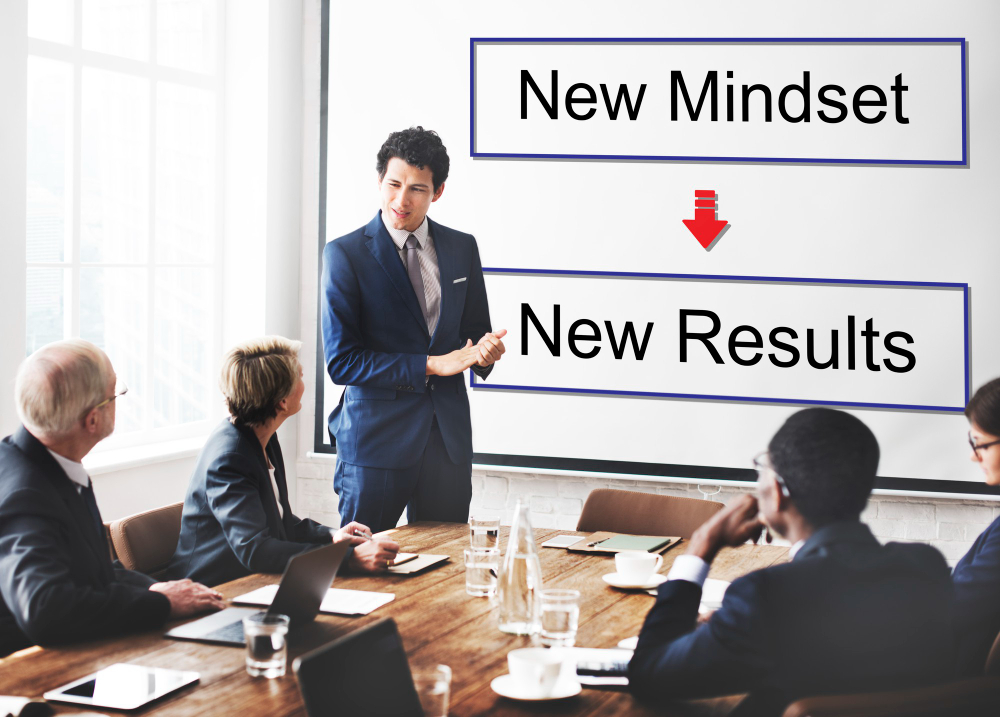Why Designers Must Embrace a Growth Mindset or Fail

In the domain of personal development and professional success, the concept of mindset plays an important role in shaping how individuals approach challenges, learning, and growth. At the core of this discussion are two distinct mindsets: the growth mindset and the fixed mindset. Understanding the differences between these mindsets is crucial for unlocking potential and achieving excellence.
The Growth Mindset: Embracing the Power of Learning and Effort
The growth mindset is rooted in the belief that abilities and talents can be developed through dedication, effort, and continuous learning. Individuals with a growth mindset see challenges as opportunities to learn and improve, viewing setbacks as stepping stones toward success. They embrace feedback, seek out new experiences, and actively cultivate their skills and knowledge.
One of the key characteristics of a growth mindset is resilience in the face of obstacles. People with a growth mindset understand that mastery takes time and effort, and they are willing to invest in their development over the long term. They see failures as temporary setbacks and setbacks as valuable learning experiences that contribute to their growth trajectory.
Individuals with a growth mindset also value collaboration and constructive criticism. They are open to different perspectives and recognize that learning from others can accelerate personal and professional growth. This mindset fosters a culture of continuous improvement and innovation, driving individuals to push beyond their comfort zones and explore new possibilities.

The Fixed Mindset: Limiting Beliefs in Innate Abilities
In contrast, the fixed mindset is characterized by the belief that abilities and talents are fixed traits that cannot be significantly changed or developed. Individuals with a fixed mindset may avoid challenges for fear of failure, believing that success is primarily determined by innate capabilities rather than effort or learning.
People with a fixed mindset tend to view setbacks as indicators of personal limitations rather than opportunities for growth. They may shy away from feedback or constructive criticism, feeling threatened by the idea of not meeting predefined expectations. This mindset can lead to stagnation and missed opportunities for personal and professional development.
Moreover, individuals with a fixed mindset may compare themselves unfavorably to others, focusing on proving their abilities rather than embracing a growth-oriented approach. This can create a sense of competition rather than collaboration, hindering both individual and collective progress.
Cultivating a Growth Mindset
The good news is that mindset is not fixed—it can be cultivated and developed over time. By recognizing the power of a growth mindset and actively adopting its principles, individuals can unlock their potential and achieve greater success in various aspects of life.
To cultivate a growth mindset, it's important to:
- Embrace challenges as opportunities for growth and learning.
- View failures as valuable lessons that contribute to personal development.
- Seek out feedback and constructive criticism to identify areas for improvement.
- Cultivate a passion for continuous learning and skill development.
- Surround oneself with supportive and growth-oriented individuals who encourage and inspire.
The Importance of Adaptability in Design
In the ever-evolving world of design, adaptability is not just a desirable trait—it's a critical necessity for success. Designers today are faced with rapid technological advancements, shifting consumer preferences, and emerging trends that demand constant innovation and flexibility. Understanding the importance of adaptability in design is key to thriving in this dynamic environment and delivering impactful solutions.
Navigating Rapid Technological Advancements and Shifting Trends
Technology is reshaping the design industry at a staggering pace. From new software tools to emerging digital platforms and innovative production techniques, designers must stay abreast of these developments to remain competitive. Similarly, consumer preferences and market trends are constantly evolving, influenced by social, cultural, and economic factors.
Designers who embrace adaptability are better equipped to respond to these changes effectively. They possess the agility to pivot strategies, adopt new technologies, and incorporate fresh ideas into their work. This flexibility allows them to stay ahead of the curve, anticipate trends, and deliver designs that resonate with contemporary audiences.

How a Growth Mindset Fosters Adaptability
At the heart of adaptability lies a growth mindset—the belief in one's ability to learn, improve, and adapt to new challenges. Designers with a growth mindset approach their work with curiosity and openness, viewing experimentation as a pathway to innovation. They are not afraid to step outside their comfort zones, take risks, and explore unconventional ideas.
A growth mindset encourages designers to learn from failures rather than be discouraged by them. It promotes resilience and a willingness to iterate, refine, and evolve designs based on feedback and insights gained through experimentation. This iterative approach is essential for adapting to changing circumstances and refining designs to meet evolving needs.
Moreover, a growth mindset fosters a culture of continuous learning and improvement within design teams. Designers who embrace this mindset actively seek opportunities to expand their skills, collaborate with diverse professionals, and explore interdisciplinary approaches. They recognize that adaptability is not just about technical proficiency but also about cultivating a mindset of flexibility and innovation.
Practical Strategies for Enhancing Adaptability
To enhance adaptability in design, designers can:
- Stay informed about industry trends and technological advancements.
- Embrace a willingness to experiment and take calculated risks.
- Seek feedback and iterate designs based on user insights.
- Collaborate with interdisciplinary teams to gain diverse perspectives.
- Foster a culture of continuous learning and professional development.
Embracing Continuous Learning in Design
Continuous learning is not just a professional obligation; it's a cornerstone of success and innovation in the dynamic field of design. Designers who prioritize ongoing education and skill development are better equipped to navigate industry changes, adapt to emerging technologies, and deliver solutions that resonate with evolving user needs. Understanding the value of continuous learning in design is essential for fostering growth, creativity, and long-term career satisfaction.
The Value of Continuous Learning in Design Professions
In the rapidly evolving landscape of design, staying current with industry trends, technologies, and best practices is essential for remaining competitive. Continuous learning allows designers to expand their knowledge base, refine their skills, and explore new approaches to problem-solving. It empowers them to push boundaries, experiment with innovative techniques, and deliver cutting-edge designs that address contemporary challenges.
Moreover, continuous learning fosters personal and professional growth. It provides opportunities for self-reflection, skill enhancement, and career advancement. Designers who engage in continuous learning are more likely to stay motivated, inspired, and fulfilled in their roles, leading to increased job satisfaction and overall well-being.
How a Growth Mindset Encourages Continuous Learning
A growth mindset is instrumental in fostering a culture of continuous learning within the design profession. Designers with a growth mindset approach their work with curiosity, enthusiasm, and a willingness to embrace new ideas. They view challenges as opportunities for growth and learning, rather than insurmountable obstacles.
A growth mindset encourages designers to seek feedback from peers, mentors, and users to gain valuable insights and improve their craft. Constructive criticism is seen as a pathway to improvement, prompting designers to iterate designs based on user needs and preferences.
Furthermore, a growth mindset motivates designers to acquire new skills and knowledge continuously. Designers with this mindset are proactive in seeking out learning opportunities, whether through formal education, workshops, online courses, or self-directed study. They recognize that mastery is a journey, not a destination, and they are committed to ongoing self-improvement.
In addition, a growth mindset encourages designers to stay updated with industry developments and emerging technologies. Designers actively seek out information about new tools, trends, and methodologies to remain agile and adaptable in their practice. By staying abreast of industry advancements, designers can leverage cutting-edge technologies and approaches to enhance their creative output and deliver impactful solutions.
Practical Strategies for Embracing Continuous Learning
To embrace continuous learning in design, designers can:
- Set learning goals and prioritize professional development activities.
- Engage in networking events, conferences, and industry seminars to stay connected with peers and thought leaders.
- Seek mentorship and guidance from experienced professionals to gain valuable insights and perspective.
- Experiment with new tools, techniques, and design methodologies to expand skill sets.
- Maintain a growth-oriented mindset by embracing challenges, seeking feedback, and celebrating learning milestones.
Overcoming Creative Blocks and Challenges in Design
Creativity is at the heart of design, but every designer encounters roadblocks and challenges that can hinder their creative process. From creative blocks to project setbacks, navigating these obstacles requires more than just technical skills—it demands a growth mindset characterized by resilience, adaptability, and problem-solving abilities.
Understanding Creative Blocks
Creative blocks are a common challenge that designers face. These blocks can manifest as a lack of inspiration, a feeling of being stuck, or an inability to generate fresh ideas. They can be triggered by pressure, fatigue, fear of failure, or even perfectionism.

How a Growth Mindset Helps
A growth mindset plays a pivotal role in overcoming creative blocks by promoting resilience and problem-solving. Here's how:
- Embracing Challenges as Opportunities: A growth mindset encourages designers to view creative blocks as temporary hurdles rather than insurmountable obstacles. Instead of giving in to frustration, they approach challenges with curiosity and a willingness to explore new ideas.
- Learning from Failures: Designers with a growth mindset understand that failure is a natural part of the creative process. They use setbacks as learning opportunities, analyzing what went wrong and using that knowledge to refine their approach in future projects.
- Seeking Feedback and Collaboration: A growth mindset fosters openness to feedback and collaboration. Designers are willing to share their work with others, seek constructive criticism, and incorporate different perspectives to overcome creative blocks.
- Adopting a Growth-Oriented Routine: Designers with a growth mindset establish routines that prioritize continuous improvement. They set aside time for exploration, experimentation, and skill development, allowing them to break free from creative stagnation.
Promoting Resilience in Project Setbacks
Design projects often encounter setbacks—whether it's missed deadlines, unexpected client feedback, or technical challenges. Resilience is key to navigating these setbacks and staying on course:
- Adapting to Change: A growth mindset enables designers to adapt quickly to changing circumstances. They remain flexible and agile, adjusting their approach when faced with unexpected challenges.
- Problem-Solving Skills: Designers with a growth mindset approach setbacks as puzzles to solve. They break down complex problems into manageable tasks, brainstorm solutions, and persist until they find viable alternatives.
- Staying Motivated and Positive: Maintaining a positive attitude is crucial in overcoming project setbacks. Designers with a growth mindset cultivate optimism, focusing on the lessons learned and the progress made rather than dwelling on setbacks.
Consider renowned designer Jony Ive, who faced numerous challenges during his tenure at Apple. Despite setbacks, Ive's growth mindset enabled him to innovate and push boundaries in product design, leading to iconic creations like the iPhone and MacBook.
Importance of Handling Criticism Constructively
In the world of design, receiving criticism is inevitable. Whether it's feedback from clients, colleagues, or users, how designers handle criticism can greatly impact their growth and success. The ability to navigate criticism constructively is a hallmark of resilience—a trait that is essential for professional development and innovation in design.
Criticism, when approached with the right mindset, can be a powerful tool for growth. It offers valuable insights into areas that need improvement and helps designers refine their work. Constructive criticism provides an opportunity to identify blind spots, challenge assumptions, and ultimately elevate the quality of design outcomes.
Moreover, handling criticism constructively fosters healthy professional relationships. It demonstrates openness to feedback, which is essential for collaboration and continuous improvement. By embracing criticism with a positive attitude, designers cultivate a culture of trust and mutual respect within their teams and with clients.
The Role of a Growth Mindset in Handling Criticism
Central to resilience in the face of criticism is the concept of a growth mindset. A growth mindset, as proposed by psychologist Carol Dweck, is the belief that abilities and intelligence can be developed through dedication and hard work. Designers with a growth mindset approach criticism as an opportunity for learning and improvement rather than a personal attack or setback.
Designers with a growth mindset view criticism as constructive feedback that can help them evolve and refine their skills. They are open to exploring different perspectives and welcome suggestions for enhancement. Instead of feeling discouraged by criticism, they see it as a stepping stone toward innovation and excellence.
Embracing Criticism for Improvement and Innovation
When designers embrace a growth mindset, they adopt specific strategies for handling criticism effectively:
- Seeking Understanding: Rather than reacting defensively, designers with a growth mindset seek to understand the intent behind the criticism. They listen actively, ask clarifying questions, and consider different viewpoints.
- Identifying Areas for Growth: Designers use criticism as a tool for self-reflection. They identify patterns in feedback and prioritize areas for improvement. This proactive approach enables them to turn criticism into actionable insights.
- Experimentation and Iteration: With a growth mindset, designers are not afraid to experiment and iterate based on feedback. They view design as an iterative process and welcome opportunities to refine their work through experimentation.
- Building Resilience: Designers with a growth mindset understand that setbacks are part of the creative process. They bounce back from criticism with renewed determination, using setbacks as motivation to innovate and push boundaries.
The Role of Innovation in Design
Innovation is not merely about creating something new; it's about solving problems creatively, improving user experiences, and anticipating future needs. In design, innovation manifests as groundbreaking concepts, disruptive products, and transformative experiences that resonate with audiences and drive business success.
Innovation is the lifeblood of design—it fuels creativity, drives progress, and propels organizations forward in a competitive landscape. In today's dynamic world, where technology evolves rapidly and consumer expectations shift constantly, the ability to innovate is paramount for staying relevant and competitive. Let's delve into the pivotal role of innovation in design and how cultivating a growth mindset fosters a culture of innovation by encouraging risk-taking and embracing new ideas.
Innovation fuels differentiation, setting brands apart from competitors and establishing a unique identity in the marketplace. It enables designers to push boundaries, challenge conventions, and explore uncharted territories, leading to breakthroughs that redefine industries and shape the future.
Impact of Innovation on Staying Competitive
In a fast-paced and hyper-competitive world, organizations must innovate continuously to maintain relevance and sustain growth. Innovation drives market differentiation, enhances customer engagement, and opens new avenues for revenue generation. By embracing innovation, companies can adapt to changing market dynamics, seize emerging opportunities, and outpace competitors.
Design plays a pivotal role in fostering innovation by envisioning user-centric solutions, integrating emerging technologies, and reimagining traditional approaches. Designers who embrace innovation are catalysts for transformation, driving organizational change and propelling business success through creative problem-solving and visionary thinking.
Fostering a Culture of Innovation with a Growth Mindset
A growth mindset is characterized by a belief in the potential for growth and improvement through effort and learning. This mindset is instrumental in fostering a culture of innovation within design teams and organizations.
- Encouraging Risk-Taking: A growth mindset encourages designers to take calculated risks and explore unconventional ideas. It embraces failure as a stepping stone to success, promoting experimentation and iteration in pursuit of innovative solutions.
- Embracing New Ideas: Designers with a growth mindset are open to diverse perspectives and new approaches. They welcome feedback, collaborate across disciplines, and embrace ambiguity, fostering an environment where creativity thrives and innovative ideas emerge.
- Iterative Problem-Solving: A growth mindset promotes iterative problem-solving, where designers continuously refine and iterate on ideas based on user feedback and evolving requirements. This iterative approach accelerates innovation by allowing for rapid experimentation and adaptation.
Examples of designers who have embraced a growth mindset to achieve success.
Elon Musk (Tesla, SpaceX): Elon Musk, the visionary entrepreneur behind Tesla and SpaceX, exemplifies a growth mindset in design and engineering. Musk's ambitious projects, such as the Tesla electric vehicles and SpaceX rockets, demonstrate a relentless pursuit of innovation and progress. Musk embraces challenges as opportunities for learning and improvement, leading to disruptive advancements in sustainable transportation and space exploration. His visionary approach to design has redefined industries and inspired a new era of technological innovation.
Yves Béhar (Fuseproject): Yves Béhar, founder of the design firm Fuseproject, is known for integrating design with social responsibility and sustainability. Béhar's work spans diverse fields, from consumer products to healthcare and urban design. His projects include the Jawbone Up fitness tracker and the One Laptop Per Child initiative. Béhar's growth-oriented mindset prioritizes human-centered design and innovative solutions that address real-world challenges. His approach underscores the transformative impact of design in driving positive change and empowering communities.
Sara Blakely (Spanx): Sara Blakely, the founder of Spanx, disrupted the fashion industry with a growth mindset focused on innovation and resilience. Blakely's journey from selling fax machines to launching Spanx, a revolutionary shapewear brand, exemplifies entrepreneurial spirit and creative problem-solving. Blakely's commitment to continuous improvement and adaptability led Spanx to introduce innovative products that redefine comfort and confidence. Her story highlights the importance of perseverance and a growth-oriented mindset in achieving entrepreneurial success through design.
Practical Tips for Cultivating a Growth Mindset in Design
Developing a growth mindset is essential for designers seeking to continuously improve their skills, embrace challenges, and drive innovation in their work. A growth mindset encourages learning, resilience, and adaptability—qualities that are instrumental in navigating the dynamic landscape of design. Here are actionable tips for designers to cultivate a growth mindset and excel in their profession:
Seek Diverse Perspectives
One key aspect of fostering a growth mindset is actively seeking diverse perspectives and feedback. Engage with colleagues, mentors, and users from diverse backgrounds to gain fresh insights and alternative viewpoints on design challenges. Embrace constructive criticism as an opportunity for growth rather than a setback. By incorporating diverse perspectives into the design process, designers can broaden their horizons and develop more inclusive and effective solutions.
Embrace Continuous Learning
Commit to lifelong learning and skill development. Set specific learning goals and allocate time regularly for self-improvement. Stay updated with industry trends, emerging technologies, and design methodologies through online courses, workshops, and webinars. Platforms like Coursera, LinkedIn Learning, and Skillshare offer a wealth of resources for designers to expand their knowledge and acquire new skills. Continuously learning and adapting keeps designers agile and equipped to tackle evolving design challenges.
Cultivate Resilience in the Face of Challenges
Embrace setbacks and failures as opportunities for growth. Develop resilience by reframing obstacles as learning experiences and focusing on solutions rather than problems. Maintain a positive attitude and persevere through challenges with determination. Reflect on past experiences to identify lessons learned and apply them to future endeavors. Building resilience strengthens a designer's ability to overcome adversity and bounce back stronger, fostering a growth-oriented mindset.
Foster a Culture of Experimentation and Iteration
Encourage experimentation and iteration in design processes. Embrace trial and error as a means of discovery and innovation. Prototype ideas quickly, gather feedback, and iterate based on insights gained. Adopt an iterative approach to problem-solving, refining designs based on user needs and feedback. Embracing a culture of experimentation promotes creativity, risk-taking, and continuous improvement—a hallmark of a growth mindset.
Engage in Cross-Disciplinary Collaboration
Collaborate with professionals from diverse disciplines to broaden perspectives and explore interdisciplinary approaches to design challenges. Engaging in cross-disciplinary collaboration fosters creativity and innovation by integrating insights from different fields. Participate in interdisciplinary workshops, attend conferences, and join collaborative projects to expand your network and leverage diverse expertise in design.
Leverage Design Thinking Methodologies
Apply design thinking methodologies to approach problems empathetically and iteratively. Design thinking emphasizes human-centered design, empathy, ideation, prototyping, and testing. By adopting a design thinking mindset, designers can empathize with users, generate innovative ideas, and iterate solutions based on real-world feedback. Design thinking frameworks provide a structured approach to problem-solving and encourage designers to embrace ambiguity and exploration.
Recommended Resources for Continuous Professional Development
- Coursera: Offers courses on design thinking, user experience (UX) design, and interaction design from top universities and institutions.
- LinkedIn Learning: Provides a diverse range of design courses taught by industry experts, covering topics such as graphic design, UI/UX, and design fundamentals.
- IDEO U: Offers online courses and workshops on design thinking and innovation led by IDEO experts.
- Books: Explore design-related books that inspire creativity and provide practical insights, such as "The Design of Everyday Things" by Don Norman and "Creative Confidence" by Tom Kelley and David Kelley.
- Design Conferences and Workshops: Attend design conferences, workshops, and meetups to network with peers, gain inspiration, and stay informed about the latest trends and best practices in design.
- Design professionals, design organizations, educational institutions, and corporations committed to advancing design excellence are eligible to join the World Design Council (WDC). Membership benefits vary depending on the category of membership, which includes individual, corporate, educational, and professional association memberships.
To become a member of the World Design Council, individuals and organizations can apply for membership through the official WDC website .
Adopting a growth mindset empowers designers to thrive in a rapidly evolving industry by fostering continuous improvement, resilience, innovation, and adaptability. Designers with a growth mindset embrace challenges as opportunities, prioritize skill development and lifelong learning, and leverage feedback to drive innovation and achieve long-term success in their careers. By cultivating a growth mindset, designers not only enhance their individual capabilities but also contribute to the advancement and evolution of the design profession as a whole.
